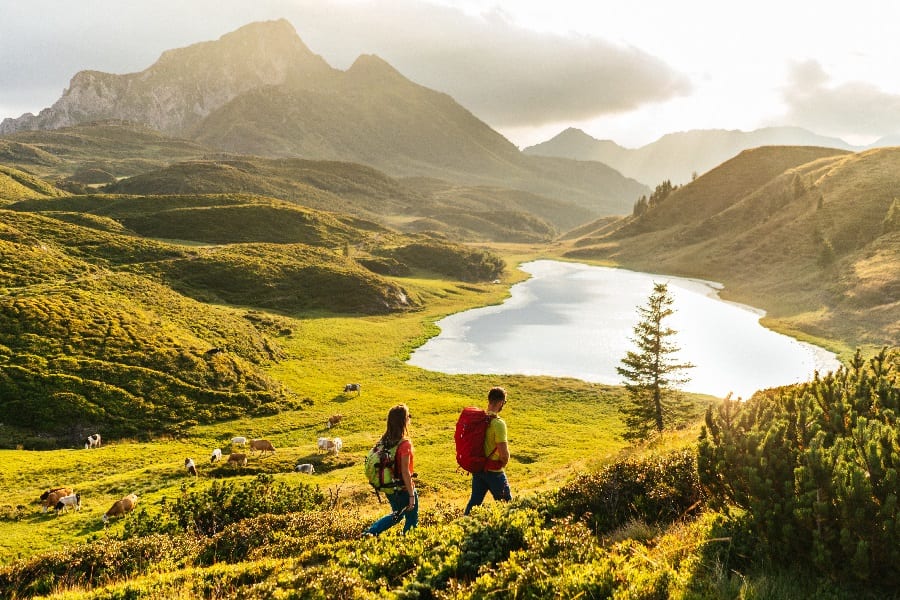Hiking is one of the most popular outdoor activities.
There is just something about being in nature that makes you feel alive. The natural breeze, waterfalls, trim trails, and best of all – the breathtaking climb to your desired destination are refreshing.
Whether you are packing for a one-day hike or a few days in the mountains, you have to keep a few things in mind.
Number one on this list is your hiking equipment, and believe it or not, the second most important thing is your clothing. That’s right!
Choosing the right outfit for a hike is more important than you think! People often make the best of carrying too many clothes. You must bring the right number of clothes; you must also choose the suitable fabric for these clothes.
Wearing a light sweater in the summer can make you feel boiling during the day. Who wears a sweater, you might ask? Well, some people do.
You might think then a pure cotton t-shirt will be perfect for a summer hike! Wrong again.
You see, cotton absorbs the sweat from your body instead of wicking it off. When the temperature drops sometime during the evening or night, the sweat-soaked cotton t-shirt will make you shiver. The sweat dampens your skin and lowers your body temperature. If you continue hiking with this sweat-laden t-shirt, you can also become hypothermic.
So, what should you wear for a hike? The most crucial part about hiking clothes is the layers. Layering keeps you warm and dry while wicking the sweat off your body.
Any hiker must wear three types of layers when going on a camping trip up in the mountains: the Baselayer, Mid-layer, and the shell layer. Let’s start with the base layer.
If you’d like to see a graphical breakdown of the hiking clothes, we got you covered:
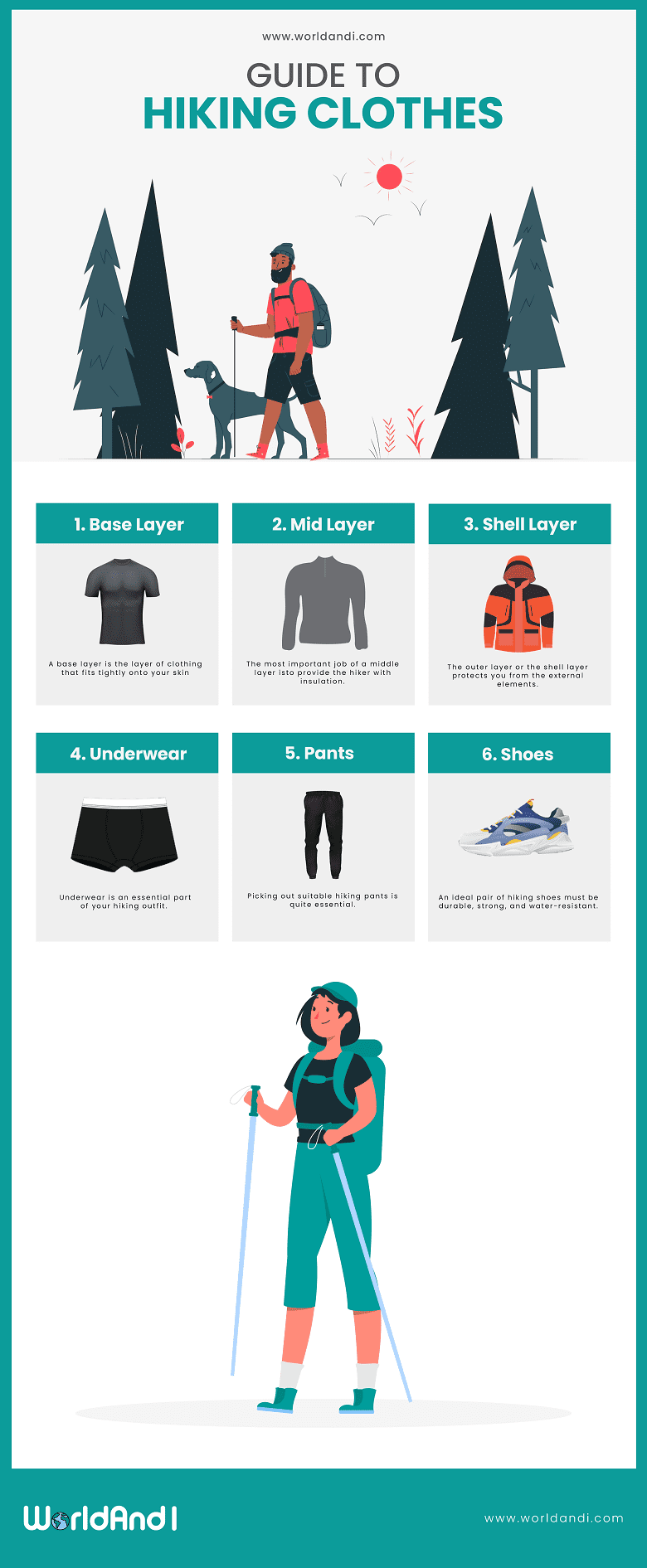
Share this Image On Your Site
<textarea onclick='this.focus();this.select()' style='width:620px;height:120px'><p><strong>Please include attribution to WorldAndI.com with this graphic.</strong><br /><br /><a href='https://www.worldandi.com/hiking-clothes/'><img src='https://www.worldandi.com/wp-content/uploads/2021/06/hiking-clothes.png' alt='hiking clothes' width='780px' border='0' /></a></p></textarea>Contents
Base Layer
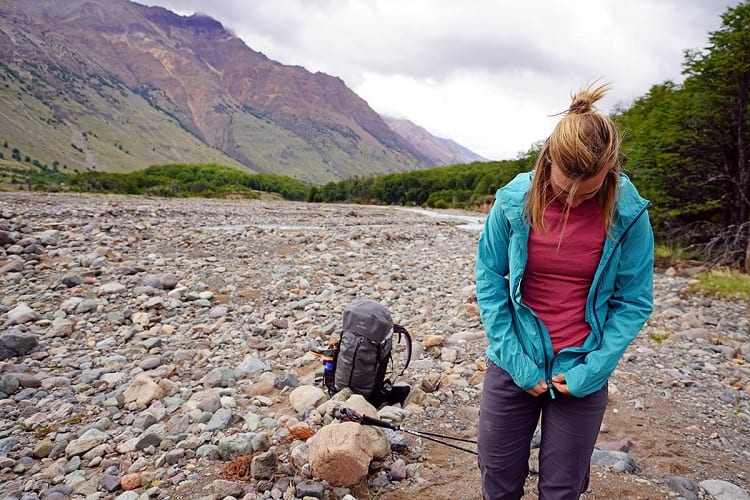
A base layer is the layer of clothing that fits tightly onto your skin. Ideally, one might think a cotton t-shirt makes a perfect base layer.
You couldn’t be more wrong. A base layer is in direct contact with your skin. The idea behind this layer is to keep the sweat off your body. Cotton t-shirts absorb moisture, so when the temperature drops, this same sweat-soaked t-shirt will make you feel cold. It is best to go for natural fibers such as wool or synthetic fibers such as nylon or polyester.
The main motive of a base layer is to keep your skin dry. Moisture management is one of the most prominent qualities of polyester. Nylon is also water-resistant and wicks the sweat right off your body. If you are going for a hike in the cold, then a woolen base layer will be the best option.
Wool keeps you warm in low temperatures. It is a breathable fabric that does not absorb sweat. Wool is odor resistant and has a high warmth-to-weight ratio. Synthetic fibers are lighter than wool, but they tend to retain odor. Depending on the weather and your personal preference, you can pick a suitable base layer. No matter which fabric you choose, make sure not to skip this layer. Professional hikers highly recommend it.
Woolen base layers are more expensive than synthetic ones. You can pick the one that fits your hiking budget. Synthetic materials dry off quickly. So, say you are happily trekking, and suddenly, out of nowhere, a light rain starts to fall. You aren’t quick enough to remove your rain jacket and get drenched. In this case, polyester will dry off quickly. If your base layer is woolen, it might take a little while to dry off.
It is best to change your clothes and put on a mid-layer in this case. Synthetic yoga pants work well as a base layer. They are comfortable but not durable. Choose pants that are both breathable and stretchable. If it is too hot, you can also wear hiking shorts. It might make you more susceptible to thorns and insects, but these things won’t matter if you are a seasoned hiker!
Mid Layer
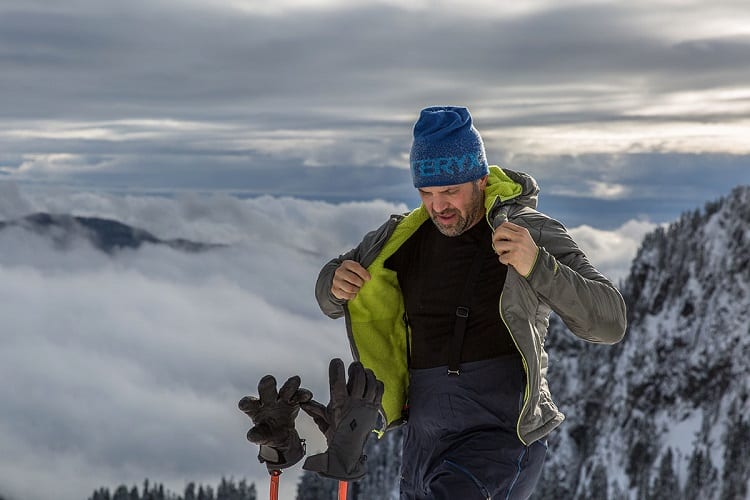
The most important job of a middle layer is to provide the hiker with insulation. The heat radiated by your body is trapped in the second layer.
This layer keeps you warm and dry. Puffy jackets or fleece sweaters work best as second layers. Make sure this jacket is warm, lightweight, and water-resistant. Since the main job of this layer is to keep you warm, don’t hesitate to invest a little extra.
Several brands sell synthetic insulation jackets and fleece insulation jackets. If you are hiking in snowy mountains, then a fleece jacket is highly recommended. If you are trekking in a hot desert, carry your second layer.
Even in the summer, deserts tend to get extremely cold during the night. The insulation layer keeps you warm at night. Suppose the weather is pleasant during the day, but it gets chilly as the sun goes down.
Hiking pants are perfect for a mid-layer. They are loose but not so loose that they cause chafing. The mid-layer must be able to accommodate the base layer. The mid-layer will provide the perfect amount of heat and warmth.
Sometimes the weather is too hot for a heavy jacket or too cold for a light nylon base layer; in this case, a good quality fleece sweater or a puffy insulating jacket will be perfect!
Shell Layer

The outer layer or the shell layer protects you from the external elements. Environmental factors like rain, wind, or snow need to be factored in while deciding what to wear for your hike.
Your outer layer needs to be made of breathable fabric. It also needs to be water-resistant. Since most hiking jackets are water-resistant, that is one thing you do not need to worry about.
Shell layers keep water or snow from seeping into the inner layers, thus protecting your body from the harsh elements of nature. If water gets to the inner layer, your body temperature can drop drastically, causing you to fall ill. Hikers use anything from an expensive mountaineering jacket to a simple wind-resistant one.
Depending on the weather, you will need to choose the right jacket for yourself. A wind jacket is excellent for warm weather. It is lightweight and provides sufficient warmth for a day trek.
Wind jackets are not usually water-resistant. So check the weather and make sure it isn’t going to rain. In case of rains, Soft Shells work the best. They are water-resistant, but their lightweight makes them a bad option for a rainstorm.
It is best to purchase a warm, water & wind resistant rain jacket for your outer layer. Choose rain pants that are thick and water-resistant. They also need to be big enough to go over your base layer and your hiking pants. You can find great brands online that sell rain pants specifically for hiking!
Underwear
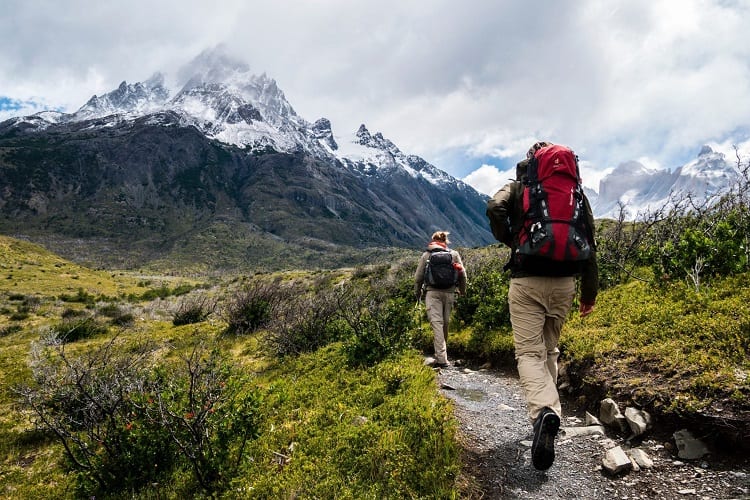
Underwear is an essential part of your hiking outfit. To ensure a comfortable hike, make sure you buy quick-drying, durable, and odor-resistant underwear.
Synthetic materials such as nylon and polyester have all of the above qualities. Some people prefer spandex, rayon, or a blend of other synthetic fibers. The key attributes of synthetic underwear are – water resistance and durability.
Synthetic materials do not absorb sweat; instead, they wick it off your body. It keeps you dry and comfortable throughout the trek. One downside to synthetic is its ability to retain order. You are bound to sweat while hiking.
The sweat causes an odor that gets trapped in the underwear. To avoid foul odor, you can use underwear made out of merino wool. Merino wool feels light on the skin, does not absorb sweat, and keeps your body odor-free for a long time.
Merino wool isn’t as dry as synthetics. Sweat settles on the surface of the wool. If the temperature rises, this moisture on the surface cools off your body. So it isn’t too much of an issue! Both merino wool and synthetic are durable. Synthetic materials are far more durable than merino wool. Each fabric has its own set of pros and cons. You can choose the one that makes you feel comfortable!
Full-cut briefs, hipster briefs, and boxer briefs are perfect for women. The three different styles provide maximum coverage and are stretchable. If you are comfortable wearing a thong or a bikini cut, that is good too. However, these types of underwear do not provide as much coverage.
When choosing a bra, make sure you wear a sports bra. The hook of a regular bra can rub against your backpack and be quite irritating. The sports bra should be snug. It shouldn’t be too tight and must be made out of breathable fabric. Comfort and water-resistance are the essential attributes of a good sports bra.
Boxer briefs, boxers, or briefs are the three best options for men. When choosing underwear, make sure to choose one that provides maximum coverage. Boxers and Boxer briefs offer great coverage. They also prevent inner-thigh chafing. In the end, you need to pick underwear that enhances wicking, has a snug fit, and feels comfortable on your skin.
A more extended cut is a preferred choice. Make sure the waistbands aren’t too tight. Your underwear should be tagless, must have flatlock seams, and should be odor resistant. You don’t want to start smelling bad right in the middle of a fun hike!
Pants
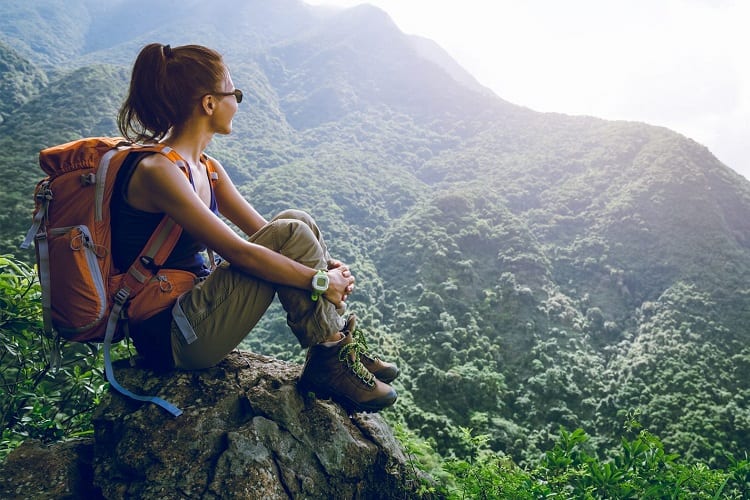
Picking out suitable hiking pants is quite essential. The perfect hiking pants provide comfort, flexibility, and durability.
These three types of pants you can use for hiking. Your regular day-to-day pants, roll-up hiking pants, and convertible hiking pants. The first one is plain and simple. You can pick it out of your wardrobe and put it on.
It may not be as durable and comfortable as the roll-up hiking pants. You can roll up these pants and turn them into shorts or capris. You can also turn convertible hiking pants into shorts. They come with zippers at the bottom half, which you can remove. You can turn your pants into shorts.
Synthetic materials are often used in these pants. They are durable, water-resistant, and are known to keep you warm. The smooth materials prevent chafing. The breathable material provides comfort and keeps your skin dry. Since nylons and other synthetic materials do not absorb water, the sweat from your body rolls off the fabric.
Make sure the pants you purchase are light. Hiking requires a lot of energy, and if you wear heavy gear, it becomes difficult to climb. The pants must fit you perfectly. They shouldn’t be too tight or too loose. The fabric must be stretchable; this ensures flexibility.
Shoes
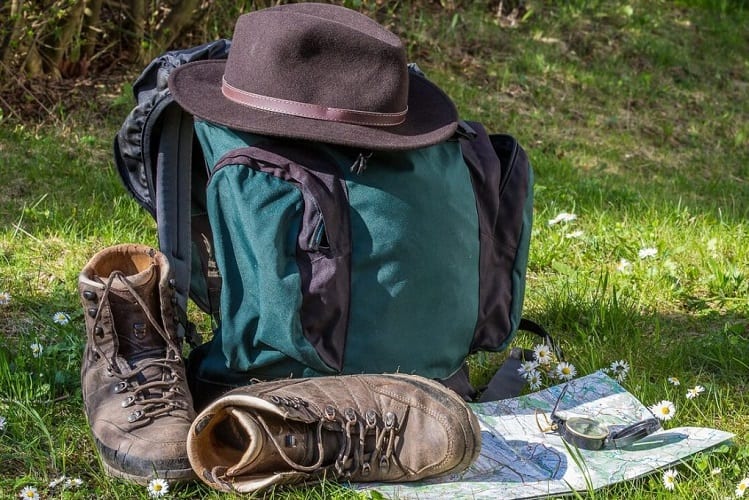
An ideal pair of hiking shoes must be durable, strong, and water-resistant.
When looking to buy a pair, make sure you choose one with a firm grip and a flexible sole. You need to check for all three layers of the sole. It should fit well and ideally have ankle support.
Hiking shoes are made out of leather or synthetics. These materials protect you from natural elements such as rain, snow, and wind while keeping your feet insulated.
A sturdy pair of hiking shoes with a snug fit is ideal. You can choose mountaineering boots, backpacking boots, or light hiking shoes. Many hiking shoes are available online; you can pick one as per your comfort and budget.
Accessories
Hiking is a fantastic experience. But being out in nature requires you to be prepared.
Going unprepared on a hike can be dangerous. Here is a list of equipment you might need on a hike. Depending on the number of days you plan to spend in nature, you can pick the essential ones.
Sturdy backpack, hiking map, hiking GPS device, navigation compass, sunscreen, bug sprays, lip balm, sunglasses, headlamp, utility knife, first aid kit, waterproof fire starter, water bottle, an emergency water filter, snacks and food, hiking poles, a tent, toilet paper, a hiking permit, trowel – to cover your deuces, rain pack cover for your bag and a printed hiking permit!
These accessories will ensure a safe, happy, comfortable hike!
Wrapping Up
We hope this guide has given you a clear sense of what you should wear on a hike.
The right accessories are also essential for a hike. Make sure you scrutinize and pack the right items. Your backpack should be light and easy to carry!
References:

